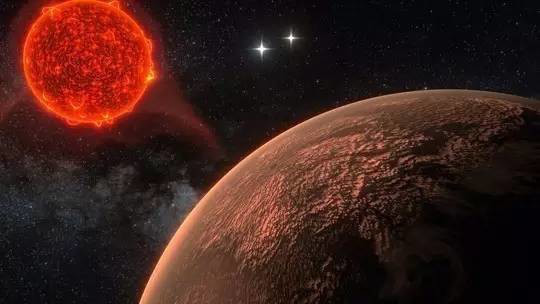(单词翻译:单击)
听力文本
This is Scientific American — 60-Second Science. I'm Steve Mirsky.
In the last two years, astronomers have found seven exoplanets around the star TRAPPIST-1, only 40 light-years away. As well as a planet called Proxima b, orbiting Proxima Centauri, a mere 4.2 light-years from us.
"I think now that we have these very nearby planets what I'm seeing in the community is all kinds of ingenuity, in terms of designing ground-based telescopes, small space-based telescopes, that are specifically...they're specifically intended to do just this one job."
Jill Tarter of the SETI Institute in Mountain View, California. SETI stands for the Search for Extraterrestrial Intelligence. Tarter was the inspiration for the Jodie Foster character in the movie Contact.
"And I'm really amazed at what I'm seeing in terms of what might be possible. Not 20 years from now, but in five years from now. For reasonable amounts of money. So the fact that these planets are now becoming places really is changing the scene."

Tarter spoke on a panel October 29th at a SETI session at Berkeley that was part of the biannual World Conference of Science Journalists. Also on the panel was Dan Werthimer, chief scientist at the Berkeley SETI Research Center. Who talked about a proposal called Breakthrough Starshot.
"And the idea is to go, and get there in 20 years and take a picture of Proxima b. It's a one-gram spacecraft. Four meters across. And it's a sail. And you deploy it in space. And you shine a laser, 50 Gigawatt laser, on it for about two minutes. And in the two minutes it accelerates at 50,000 g's. And gets up to about 20 percent the speed of light. And then it goes there and takes a picture and sends it back."
If that all worked, we could have a photograph of an exoplanet only 24 years after launch from Earth: 20 years to get there and four years for the photo to arrive back here. If that does not sound impressive consider that our current highest speed spacecraft would need 30,000 years to reach Proxima b. And I don't have that kind of time.
For Scientific American — 60-Second Science. I'm Steve Mirsky.
参考译文
这里是科学美国人——60秒科学。我是史蒂夫·米尔斯基。
在过去的两年中,天文学家在TRAPPIST-1行星周围发现了7颗系外行星,那里距地球仅有40光年。同时,他们还发现了围绕半人马座比邻星运行的比邻星b,而那里距我们仅有4.2光年。
“我认为现在我们发现了这些近在咫尺的行星,我在学界看到了地基望远镜和小型天基望远镜,它们在设计方面拥有各种不同的精巧性,而这些望远镜是专门为这项工作设计的。”
加州山景城搜寻地外文明研究所(SETI)的吉尔·塔特说到。SETI是“搜寻地外文明”的英文简写。塔特是电影《超时空接触》中朱迪·福斯特所饰演角色的原型。
“在亲眼目睹了看似不可能的东西后,我的确惊叹不已。不是从现在往后的20年,而是往后5年。所花的经费很合理。这些行星正成为一些改变地球环境的场所。”
10月29日,在伯克利举行的一次“搜寻地外文明计划”会议上,塔特发表了小组讲话。这次会议也是一年两次的世界科学记者大会的一部分。加利福尼亚大学伯克利分校搜寻地外文明计划研究中心的首席科学家丹· 沃斯名也在这个小组。他谈到了“突破摄星”项目。
“这个项目刚刚启动,计划在20年内到达半人马座比邻星b并拍下图片。执行任务的宇宙飞船只有1克重。宽约4米。让这种飞船去太空航行。飞船发射一束500亿瓦的激光,到达比邻星b需要约2分钟。在这两分钟内,激光增至50万亿瓦,速度则大概是光速的20%。然后激光到达比邻星b,拍下照片并发送回地球。”
如果一切顺利,飞船从地球发射后,仅需24年我们就可以看到系外行星的照片:飞船用20年的时间到达那里,而照片花4年时间返回地球。如果24年听起来并不令人惊叹,那请想一下:目前速度最快的宇宙飞船到达比邻星b需要30000年。我可没有那么多时间。
谢谢大家收听科学美国人——60秒科学。我是史蒂夫·米尔斯基。
译文为可可英语翻译,未经授权请勿转载!
重点讲解
重点讲解:
1. as well as 除…之外;也;还;
例句:Scientists should be literate and articulate as well as able to handle figures.
科学家除了要能处理数字,还应该具有文学素养和善于表达。
2. all kinds of 各种类型的;五花八门的;
例句:Small as it is, the shop stocks all kinds of wares.
商店虽小,各样货物俱全。
3. in terms of 在…方面;从…角度看;根据…来说;
例句:It can not be measured in terms of money.
这是不能用金钱衡量的。
4. stand for (某个字母)是…的缩写,代表,表示;
例句:The letters ERM stand for Exchange Rate Mechanism.
字母ERM是汇率机制的缩写。


